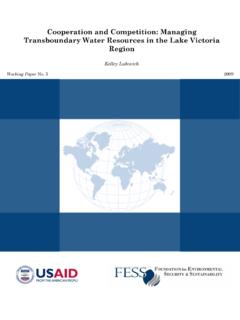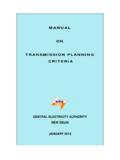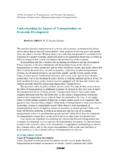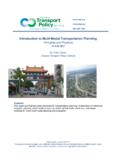Transcription of Climate Change and Conflict in Uganda: The Cattle Corridor ...
1 Climate Change and Conflict in uganda : The Cattle Corridor and Karamoja February 2011. This publication was produced for review by the United States Agency for International Development. It was prepared by Jeffrey Stark, Director of Research and Studies, Foundation for Environmental Security and Sustainability. ACKNOWLEDGEMENTS. The FESS field research team would like to acknowledge the contributions of Mr. Sileshi Tsegaye, who participated as an advisor who contributed valuable input in uganda , and Dr. Katsuaki Terasawa of the Naval Postgraduate School, who provided expertise analyzing and discussing Climate Change data. Additional thanks also are due to James Wole, the executive director of Caritas in Kotido, who helped arrange meetings and interviews in Karamoja, as well as Agnes Atyang of FEWS NET in Kampala and Gideon Galu of FEWS NET in Nairobi, whose efforts facilitated the collection of rainfall data from the Department of Meteorology of uganda .
2 COVER PHOTO: Jeffrey Stark Karamoja, uganda , June 2010. Climate Change and Conflict in uganda : The Cattle Corridor and Karamoja CMM Discussion Paper No. 3. DISCLAIMER. Discussion Papers have been commissioned by the Office of Conflict Management and Mitigation to initiate or advance consideration of important issues of Conflict prevention or peacebuilding. As such they are not official documents. The author's views expressed in this publication do not necessarily reflect the views of the United States Agency for International Development or the United States Government. CONTENTS. ACRONYMS .. ii EXECUTIVE SUMMARY .. 1. Background .. 1. Ugandan Context .. 2. Pastoralism in uganda .. 2. Climate Change and Conflict in Luwero, Nakaseke, and Nakasongala Districts .. 3. Climate Change and Conflict in 3. Climate Change Data Limitations .. 5. Concluding 5. INTRODUCTION .. 7. METHODOLOGY .. 9. Areas Visited and Organizations and Individuals 11.
3 THE UGANDAN CONTEXT .. 13. Ethnic Division and Political Conflict (1962-1985) .. 13. Economic Growth, Democratic Hopes, and Democratic Decline (1986-2010) .. 14. PASTORALISM AND Climate Change IN THE. Cattle Corridor .. 19. The Environmental Advantages and Practical Predicament of Pastoralism .. 19. Climate , Natural Resource Management, and Conflict in Luwero, Nakaseke, and Nakasongola Districts .. 20. Karamoja: Culture, State, and Conflict .. 23. Poverty, Drought, and Climate Change Impacts in Karamoja .. 26. Climate Change and the Data Dilemma .. 31. i CONCLUSION .. 35. RECOMMENDATIONS .. 41. RESOURCES .. 45. Appendix 45. Appendix II .. 50. References .. 52 ii ACRONYMS. ADRA Adventist Development and Relief Agency CAF Conflict Assessment Framework CCCAF Climate Change and Conflict Assessment Framework CCU Climate Change Unit CEWARN Conflict Early Warning and Response Mechanism CMM Office of Conflict Management and Mitigation CPR Common Pool Resources DRC Democratic Republic of the Congo ESAF Environmental Security Assessment Framework FAO Food and Agriculture Organization FESS Foundation for Environmental Security and Sustainability FEWS NET Famine Early Warning Systems Network FFP Food for Peace IDP Internally Displaced Persons IK Indigenous Knowledge IPCC Intergovernmental Panel on Climate Change KAPFS Karamoja Action Plan for Food Security KIDDP Karamoja Integrated Disarmament and Development Programme LRA Lord's Resistance Army MWE Ministry of Water and Environment NAPA National Adaptation Programmes of Action NRA National Resistance Army NRM National Resistance
4 Movement OFDA Office of Foreign Disaster Assistance PELUM Participatory Ecological Land Use Management iii PENHA Pastoral and Environmental Network in the Horn of Africa UNDP United Nations Development Programme UNFPA United Nations Population Fund UNOCHA United Nations Office for the Coordination of Humanitarian Affairs UPDA uganda People's Democratic Army UPDF uganda People's Defence Force USAID United States Agency for International Development USDA United States Department of Agriculture VEDCO Volunteer Efforts for Development Concerns WFP World Food Program iv EXECUTIVE SUMMARY. BACKGROUND. In 2007, the Intergovernmental Panel on Climate Change (IPCC) projected that rising global temperatures will contribute to an upsurge in severe storms, floods, droughts, glacier melt, and sea level rise. Such Climate -related events clearly have the potential to impede or reverse economic development and generate humanitarian crises in vulnerable areas of the developing world, but will Climate Change also lead to Conflict ?
5 From 2007 to 2009, a series of well-publicized policy studies addressed this question and concluded that there is a strong likelihood that the natural hazards and environmental stresses associated with Climate Change will have destabilizing social and political consequences and trigger or amplify Conflict . One academic study published in the Proceedings of the National Academy of Sciences analyzed historical linkages between civil war and temperatures in sub-Saharan Africa and suggested a 54 percent increase in armed Conflict incidence by 2030. Only a few studies took a more nuanced and skeptical view of the Climate - Conflict linkage. In the context of such projections of Conflict driven by Climate Change , the Office of Conflict Management and Mitigation (CMM) of the Agency for International Development (USAID) asked the Foundation for Environmental Security and Sustainability (FESS) to review the current state of knowledge about Climate Change and Conflict linkages.
6 FESS concluded that the analysis of the Climate - Conflict relationship to date is very largely conceptual, schematic, and deductive and noted the need for a more focused and contextual approach to the understanding of the Climate - Conflict relationship in specific countries or regions. Relatively little field research has been done to look at the interaction between Climate Change at the national or subnational level and the political, social, economic, and cultural specificities of selected Conflict -prone states. This is due, in part, to the challenges of obtaining downscaled Climate data and the difficulties that still remain in producing multifaceted Conflict studies that use evidence-based analysis to advance conclusions of broader applicability. The main purpose of this case study is to help fill this gap in knowledge. USAID/CMM asked FESS to produce case studies on Climate Change and Conflict in selected countries, with a view to producing findings relevant to Agency and Mission interests and programs.
7 The first of these case studies is the present study, focusing on the so-called Cattle Corridor and the area of Karamoja. To conduct its first Climate Change and Conflict case study and guide its methodological approach, FESS relied on elements of both its Environmental Security Assessment Framework (ESAF) and core components of USAID's Conflict Assessment Framework (CAF). Both the ESAF and CAF emphasize one of the main conclusions of recent Conflict analyses: Conflict is almost always the result of the interactions of multiple political, economic, social, historical, and cultural factors, and it is never driven by a single causal factor. This study on the potential effects of Climate Change on Conflict situates the Ugandan case within this broader context. From June 26, 2010 to July 9, 2010, the two-person FESS research team conducted 52 interviews and met with more than 110 persons from local communities, civil society organizations, local and national government, elected officials, and international organizations.
8 Interviews were conducted in Kampala and selected districts within the Cattle Corridor and Karamoja. Questions were asked of interviewees to get their perceptions concerning such issues as: the impact of environmental and climatic Change ; the coping capacities and resilience of affected groups; the responses of local and national governments; the drivers of Conflict and their linkages, if any, with Climate Change ; steps needed to 1. address any Climate -related challenges with potential Conflict linkages; and anticipated Conflict trends with potential linkages to Climate Change over the next ten years. THE UGANDAN CONTEXT. Yoweri Museveni became the president of uganda in 1986. After a quarter century of military coups, ethnic Conflict , economic crises, political chaos, and massive violence, Museveni set out to stabilize a country desperate for peace and security. Viewed from the perspective of macroeconomy, uganda has had considerable success under President Museveni.
9 In the late 1980s, he instituted reforms to liberalize the Ugandan economy. GDP growth during the Museveni era has been consistently at or above the 6 percent annual growth rate necessary to outpace a rapidly growing population, which has more than doubled during his tenure. Since the mid-1990s, inflation has been held in check, and national poverty levels also have decreased. Nevertheless, the demographic composition of population growth about half the population is now under 15 years of age means that job creation has become a major challenge for the country. By the mid-1990s, Museveni was receiving international praise as one of a new breed of promising African leaders. Notwithstanding these early assessments, Museveni's re-elections in 2001, 2006, and 2011 were marked by often repressive and divisive campaigns that disappointed hopes for increased democratic competition and soured most observers on Museveni's democratic credentials.
10 In the late 1990s, uganda became embroiled in the political turmoil and armed Conflict of its neighbor, the Democratic Republic of the Congo (DRC). The uganda People's Defence Force (UPDF) controlled the northeast corner of the resource-rich DRC and allegedly became engaged in the illicit extraction of such resources as gold, diamonds, timber, coltan, ivory, and coffee. Although denounced by the Ugandan government, a 2010 UN report stated that Ugandan troops engaged in torture and various other cruel, inhuman, or degrading treatments while in the DRC. From the late 1980s until recently, northern uganda was afflicted by the war between the Lord's Resistance Army (LRA) and the Government of uganda . The roots of the LRA and its evolution as a rebel movement are complex, but today it is largely known for its attacks on northern villages and brutal atrocities against civilians. The LRA was eventually subdued in uganda and displaced to neighboring countries but at the cost of more than a million internally displaced persons, years of skirmishes with the UPDF, and continuing regional instability.






